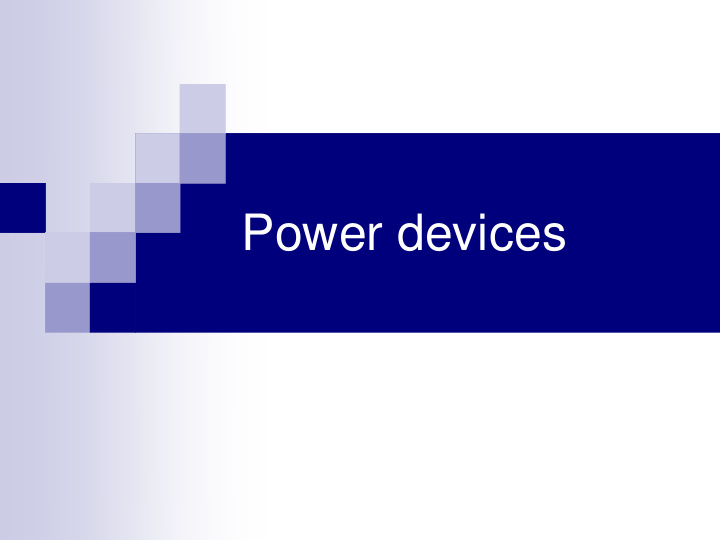



Power devices
◼ Power BJT - “Large” devices to reduce current density - Structure is similar to the integrated BJT, but there is no need to have the collector contact on the upper face -> collector contact at the bottom - interleaved B/E structure to reduce emitter crowding
◼ Power FET - to reduce the electric field: double implantation (with n - on the drain side) - Vertical structures are possible. E.g.: VMOS
In a MOSFET when T increases (e.g. due to - power dissipation) I decreases (because m decreases: it’s a drift based device) - > it’s easy to put many of them in parallel. E.g.: HexFET
Four-layer devices 9.5 ◼ Although transistors make excellent switches, they have limitations when it comes to switching high currents at high voltages ◼ In such situations we often use devices that are specifically designed for such applications ◼ These are four-layer devices they amplify in the sense that a small current controls a large current but can only be on or off , as relays moreover, they can only be switched on (not off!!)
Four-layer devices ◼ operation construction resembles two interconnected bipolar transistors turning on T2 holds on T1 T1 keeps T2 on… device then conducts until the current goes to zero.
Four-layer devices ◼ This was the basic 4-layer device ◼ Bilateral version of the 4-layer device: Diac ◼ If current is injected in the base of (e.g.) the npn, the switch-on (but not the switch-off!) can be controlled: SCR or thyristor ◼ Bilateral version of the SCR: Triac
Four-layer devices (contd.) ◼ The SCR a four-layer device with a pnpn structure three terminals: anode, cathode and gate gate is the control input.
Four-layer devices (contd.) ◼ Use of a thyristor in AC power control once triggered the device conducts for the remainder of the half cycle varying firing time determines output power allows control from 0 – 50% of full power
Four-layer devices (contd.) ◼ Full-wave power control using thyristors full-wave control requires two devices allows control from 0 – 100% of full power requires two gate drive circuits opto-isolation often used to insulate circuits from AC supply
Four-layer devices (contd.) ◼ The triac resembles a bidirectional thyristor allows full-wave control using a single device the triac is often used with a bidirectional trigger diode (a diac ) to produce the necessary drive pulses the latter breaks down at particular voltage and fires the triac
Four-layer devices (contd.) ◼ A simple lamp-dimmer using a triac
Other power devices Besides ◼ power BJTs ◼ power MOSFETs ◼ thyristors other power devices do exist: ◼ GTOs, gate turn-off thyristors ◼ IGBTs, insulated gate bipolar transistors ◼ MCTs, MOS controlled thyristors
◼ Other power devices - GTOs, gate turn-off thyristors - can also be switched off (however, a rather large current is needed) - IGBTs, insulated gate bipolar transistors - high input impedence (similar to MOSFETs) - low V ON (similar to BJTs) - MCTs, mos controlled thyristors - it’s more or less a thyristor controlled by a MOSFET
◼ A (rough) comparison of performances device power speed BJT medium medium MOSFET medium high thyristor very high very low GTO high low IGBT medium medium MCT medium medium
[Spectrum, May 2014] ◼ Wide-bandgap semiconductors can operate stably at high temperatures and frequencies ◼ For medium currents and thermal loads where extremely fast and efficient switching is required, Gallium nitride (GaN) is optimal ◼ For very high currents and thermal loading where large amounts of energy need to be processed in a small area (e.g. in a vehicular motor drive) silicon carbide (SiC) is the best choice.
Application map of power devices (2014)
Cross section of the elementary cell of (a) traditional planar MOSFETs and (b) state-of-the-art (2014) trench MOSFETs
Recommend
More recommend